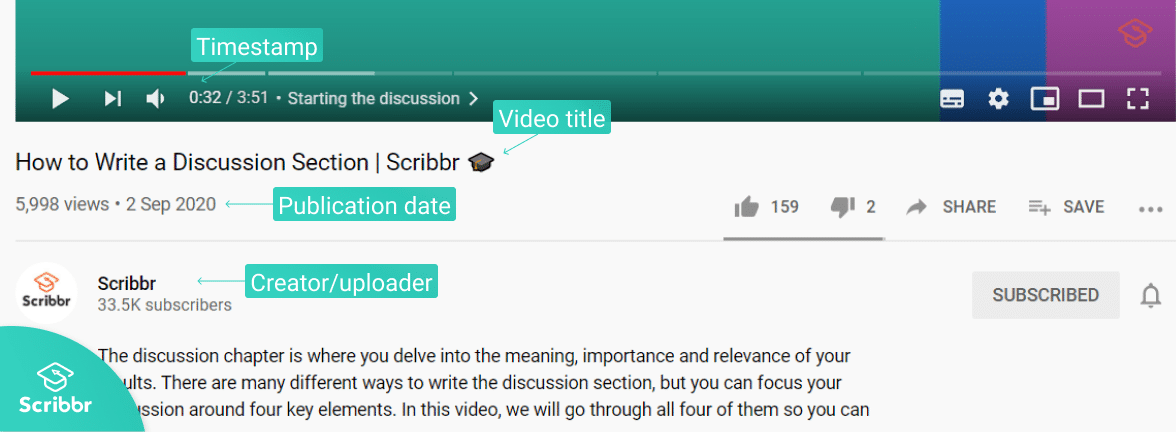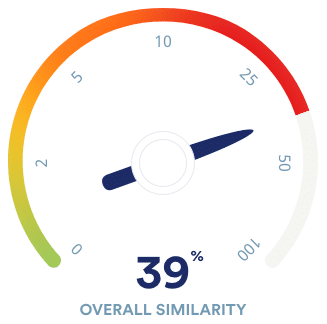How to Cite a Video in Text Mla
How to cite a YouTube video in MLA
Published on April 18, 2019 by Courtney Gahan. Revised on June 16, 2021 by Shona McCombes.
The MLA Works Cited entry for an online video contains the video's creator, the title, the website or platform in italics (e.g. YouTube), the channel or user that uploaded the video, the upload date, and the URL.
If the video was uploaded by the same person or organization that created it, or if no clear creator can be identified, omit the author element and start with the video's title instead.
The in-text citation should match the first element of the Works Cited (either the creator's name, or a short version of the title). You can also include a timestamp in place of a page number.
Note that if you are citing a whole movie that has been uploaded to a video-sharing platform, you should use the format of an MLA movie citation instead. The same goes for a TV episode. For a TED Talk, you can follow the YouTube format if you cite it from YouTube.
Finding information for an MLA YouTube citation
On YouTube, all the information you need can be found below the video.
The name of the channel that uploaded the video should be written the same as it is on YouTube, but the title of the video should follow standard MLA capitalization rules.

Citing videos with the same creator and uploader
YouTube videos are often uploaded by the person or organization that created them. In this case, their name should only appear once. Start the citation with the title, and list the channel name in the other contributors element.
In the example below, the video was both created and uploaded by the organization BBC News, so the reference starts with the title. A shortened version of the title appears in the in-text citation.
| Format | "Title of Video." Website , uploaded by Username, Day Month Year, URL. |
| Works Cited entry | "First Look Inside Notre-Dame after Fire." YouTube, uploaded by BBC News, 16 Apr. 2019, www.youtube.com/watch?v=2Zpw_KAEhDY. |
| In-text citation | ("First Look Inside") |
What is your plagiarism score?
Compare your paper with over 60 billion web pages and 30 million publications.
- Best plagiarism checker of 2020
- Plagiarism report & percentage
- Largest plagiarism database
Scribbr Plagiarism Checker

Citing videos with a different creator and uploader
Sometimes, you might want to cite a video that has been uploaded by someone other than the creator.
In this case, if you know who created the video, list them as author at the start of the Works Cited and in the in-text citation.
| Format | Creator last name, First name. "Title of Video." Website , uploaded by Username, Day Month Year, URL. |
| Works Cited entry | Newsom, Joanna. "'Sapokanikan' (Official Video)." YouTube, uploaded by Drag City, 10 Aug. 2015, www.youtube.com/watch?v=ky9Ro9pP2gc. |
| In-text citation | (Newsom) |
You should also use this format if you are citing an interview uploaded to YouTube, using the interviewee's name as the author.
Timestamps in YouTube citations
If you directly quote from a video, or you want to refer to a specific section, you can include a timestamp in your in-text citation.
| Works Cited entry | "My Australia: Koryom Nyuon." YouTube, uploaded by SBS News, 1 Apr. 2019, www.youtube.com/watch?v=7C2PevCgQQM. |
| In-text citation | ("My Australia: Koryom Nyuon" 00:14–35). |
Frequently asked questions about MLA style
Is this article helpful?
You have already voted. Thanks :-) Your vote is saved :-) Processing your vote...
How to Cite a Video in Text Mla
Source: https://www.scribbr.com/mla/youtube-citation/